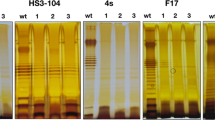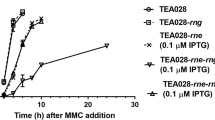Abstract
We investigated the relationship between expression of the O side chain of outer membrane lipopolysaccharide (LPS) and infection by a Shiga toxin 2 (Stx2)-converting phage in normal and benign strains of Escherichia coli. Of 19 wild-type E. coli strains isolated from the feces of healthy subjects, those with low-molecular-weight LPS showed markedly higher susceptibility to lytic and lysogenic infection by Stx2 phages than those with high-molecular-weight LPS. All lysogens produced infectious phage particles and Stx2. The Stx-negative E. coli O157:H7 strain ATCC43888 with an intact O side chain was found to be resistant to lysis by an Stx2 phage and lysogenic infection by a recombinant Stx2 phage, whereas a rfbE mutant deficient in the expression of the O side chain was readily infected by the phage and yielded stable lysogens. The evidence suggests that an O side chain deficiency leads to the creation of new pathotypes of Shiga toxin-producing E. coli (STEC) within the intestinal microflora.


Similar content being viewed by others
Literature Cited
Beutin L, Krause G, Zimmermann S, Kaulfuss S, Gleier K (2004) Characterization of Shiga toxin-producing Escherichia coli strains isolated from human patients in Germany over a 3-year period. J Clin Microbiol 42:1099–1108
Bilge SS, Vary JC Jr, Dowell SF, Tarr PI (1996) Role of the Escherichia coli O157:H7 O side chain in adherence and analysis of an rfb locus. Infect Immun 64:4795–4801
Boerlin P, McEwen SA, Boerlin-Petzold F, Wilson JB, Johnson RP, Gyles CL (1999) Associations between virulence factors of Shiga toxin-producing Escherichia coli and disease in humans. J Clin Microbiol 37:497–503
Bradley DE (1989) Interaction of drug resistance plasmids and bacteriophages with diarrheagenic strains of Escherichia coli. Infect Immun 57:2331–2338
Camprubi S, Sabater E, Regue M, Tomas JM (1989) The influence of the O-antigen and the capsular polysaccharide on the establishment of PICmts lysogeny in Klebsiella pneumoniae. FEMS Microbiol Lett 60:67–69
Datsenko KA, Wanner BL (2000) One-step inactivation of chromosomal genes in Escherichia coli K-12 using PCR products. Proc Natl Acad Sci USA 97:6640–6645
Eklund M, Scheutz F, Siitonen A (2001) Clinical isolates of non-O157 Shiga toxin-producing Escherichia coli: serotypes, virulence characteristics, and molecular profiles of strains of the same serotype. J Clin Microbiol 39:2829–2834
Eklund M, Leino K, Siitonen A (2002) Clinical Escherichia coli strains carrying stx genes: stx variants and stx-positive virulence profiles. J Clin Microbiol 40:4585–4593
Gamage SD, Strasser JE, Chalk CL, Weiss AA (2003) Nonpathogenic Escherichia coli can contribute to the production of Shiga toxin. Infect Immun 71:3107–3115
Griffin PM (1995) Escherichia coli O157:H7 and other enterohemorrhagic Escherichia coli. In: Blaser MJ, Smith PD, Ravdin JI, Greenberg HB, Guerrant RL (eds) Infections of the gastrointestinal tract. New York: Raven Press, pp 739–762
Hantke K (1978) Major outer membrane proteins of E. coli K12 serve as receptors for the phages T2 (protein 1) and 434 (protein 1). Mol Gen Genet 164:131–135
Hayashi T, Makino K, Ohnishi M, Kurokawa K, Ishii K, Yokoyama K, Han CG, Ohtsubo E, Nakayama K, Murata T, Tanaka M, Tobe T, lida T, Takami H, Honda T, Sasakawa C, Ogasawara N, Yasunaga T, Kuhara S, Shiba T, Hattori M, Shinagawa H (2001) Complete genome sequence of enterohemorrhagic Escherichia coli O157:H7 and genomic comparison with a laboratory strain K-12. DMA Res 28:11–22
Hitchcock PJ, Brown TM (1983) Morphological heterogeneity among Salmonella lipopolysaccharide chemotypes in silver-stained polyacrylamide gels. J Bacteriol 154:26–277
Iyoda S, Watanabe H (2005) CIpXP protease controls expression of the type III protein secretion system through regulation of RpoS and GrIR levels in enterohemorrhagic Escherichia coli. J Bacteriol 187:4086–4094
Izumiya H, Terajima J, Wada A, Inagaki Y, Ito K, Tamura K, Watanabe H (1997) Molecular typing of enterohemorrhagic Escherichia coli O157:H7 isolates in Japan by using pulsed-field gel electrophoresis. J Clin Microbiol 35:1675–1680
James CE, Stanley KN, Allison HE, Flint HJ, Stewart CS, Sharp RJ, Saunders JR, McCarthy AJ (2001) Lytic and lysogenic infection of diverse Escherichia coli and Shigella strains with a verocytotoxigenic bacteriophage. Appl Environ Microbiol 67:4335–4337
Johnson AD, Poteete AR, Lauer G, Sauer RT, Ackers GK, Ptashne M (1981) Lambda represser and cro-components of an efficient molecular switch. Nature 294:217–223
Kaper JB, O’Brien AD, (1998) Escherichia coli O157:H7 and other Shiga toxin-producing E. coli strains. Washington, D.C.: ASM Press
Muniesa M, Jofre J (1998) Abundance in sewage of bacteriophages that infect Escherichia coli O157:H7 and that carry the Shiga toxin 2 gene. Appl Environ Microbiol 64:2443–2448
Muniesa M, Blanco JE, De Simon M, Serra-Moreno R, Blanch AR, Jofre J (2004) Diversity of stx2 converting bacteriophages induced from Shiga-toxin-producing Escherichia coli strains isolated from cattle. Microbiology 150:2959–2971
Nataro JP, Kaper JB (1998) Diarrheagenic Escherichia coli. Clin Microbiol Rev 11:142–201
Neely MN, Friedman DI (1998) Arrangement and functional identification of genes in the regulatory region of lambdoid phage H-19B, a carrier of a Shiga-like toxin. Gene 223:105–113
O’Brien AD, Newland JW, Miller SF, Holmes RK, Smith HW, Formal SB (1984) Shiga-like toxin-converting phages from Escherichia coli strains that cause hemorrhagic colitis or infantile diarrhea. Science 226:69–696
Osawa R, lyoda S, Nakayama SI, Wada A, Yamai S, Watanabe H (2000) Genotypic variations of Shiga toxin-converting phages from enterohaemorrhagic Escherichia coli O157: H7 isolates. J Med Microbiol 49:565–574
Plunkett G 3rd, Rose DJ, Durfee TJ, Blattner FR (1999) Sequence of Shiga toxin 2 phage 933W from Escherichia coli_ O157:H7: Shiga toxin as a phage late-gene product. J Bacteriol 181:1767–1778
Schmidt H, Bielaszewska M, Karch H (1999) Transduction of enteric Escherichia coli isolates with a derivative of Shiga toxin 2-encoding bacteriophage phi3538 isolated from Escherichia coli O157:H7. Appl Environ Microbiol 65:3855–3861
Smith HR, Day NP, Scotland SM, Gross RJ, Rowe B (1984) Phage-determined production of vero cytotoxin in strains of Escherichia coli serogroup O157. Lancet 2:1242–1243
Smith HW, Green P, Parsell Z (1983) Vero cell toxins in Escherichia coli and related bacteria: transfer by phage and conjugation and toxic action in laboratory animals, chickens and pigs. J Gen Microbiol 129:3121–3137
Toth I, Schmidt H, Dow M, Malik A, Oswald E, Nagy B (2003) Transduction of porcine enteropathogenic Escherichia coli with a derivative of a Shiga toxin 2-encoding bacteriophage in a porcine ligated ileal loop system. Appl Environ Microbiol 69:7242–7247
van der Ley P, de Graaff P, Tommassen J (1986) Shielding of Escherichia coli outer membrane proteins as receptors for bacteriophages and colicins by O-antigenic chains of lipopolysaccharide. J Bacteriol 168:449–451
Wagner PL, Neely MN, Zhang X, Acheson DW, Waldor MK, Friedman DI (2001) Role for a phage promoter in Shiga toxin 2 expression from a pathogenic Escherichia coli strain. J Bacteriol 183:2081–2085
Watarai M, Sato T, Kobayashi M, Shimizu T, Yamasaki S, Tobe T, Sasakawa C, Takeda Y (1998) Identification and characterization of a newly isolated shiga toxin 2-converting phage from shiga toxin-producing Escherichia coli. Infect Immun 66:4100–4107
Wertman KF, Wyman AR, Botstein D (1986) Host/vector interactions which affect the viability of recombinant phage lambda clones. Gene 49:253–262
Yu F, Mizushima S (1982) Roles of lipopolysaccharide and outer membrane protein OmpC of Escherichia coli K-12 in the receptor function for bacteriophage T4. J Bacteriol 151:718–722
Acknowledgments
This work was supported by grants-in-aid for science research from the Ministry of Education, Science and Culture of Japan, the Ministry of Health and Welfare of Japan, and the Japan Health Science Foundation.
Author information
Authors and Affiliations
Corresponding author
Rights and permissions
About this article
Cite this article
Iguchi, A., Iyoda, S., Watanabe, H. et al. O Side Chain Deficiency Enhances Sensitivity of Escherichia coli to Shiga Toxin 2-Converting Bacteriophages. Curr Microbiol 54, 14–19 (2007). https://doi.org/10.1007/s00284-006-0139-x
Received:
Accepted:
Published:
Issue Date:
DOI: https://doi.org/10.1007/s00284-006-0139-x




